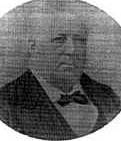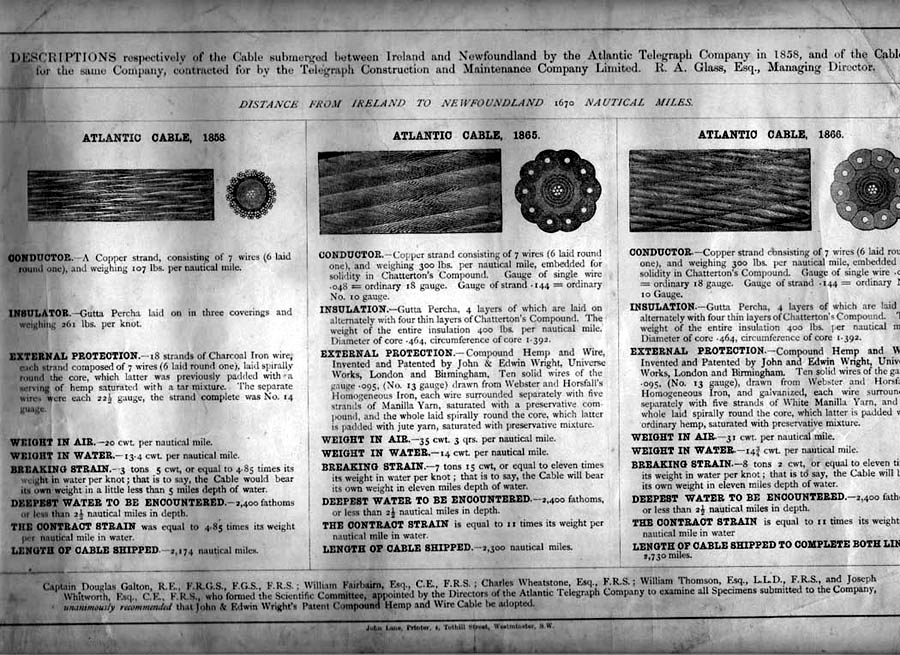
| Relationship to me: | First Cousins Four Times Removed | Gen -4 |  |
| Born: | Dumfries, Scotland | 4 Jun 1824 | |
| Died: | London, | 17 May 1893 | |
| Age | 69 | ||
| Father: | John Anderson | 1792 - 1858 | |
| Mother: | Agnes Richardson | 1794 - 1886 | |
| Brothers: | Robert Anderson | c.1827 | |
| David Anderson | c,1828 | ||
| Wellwood Anderson | 1829 | ||
| John Anderson | c.1830 | ||
| William Anderson | c.1831 | ||
| Sisters: | Agnes Anderson | 1825 | |
| Elizabeth Anderson | c.1826 | ||
| Married: | (1) Mary Stewart | 1824 - 1856 | |
| (2) Margaret Milligan | 1826 - 1891 | ||
| Children: | (1) Wellwood Anderson | 1854 - 1893 | |
| (2) Kenneth Anderson |
James Anderson was the captain of the Great Eastern Steamship at the time that it successfully laid the first Altantic Cable - the telegraph cable that opened up 'instant' communications between Great Britain and the USA. James was knighted for his role in this great venture.
The S.S.
Great Eastern was designed by Isambard Kingdom Brunel - one of the great
engineers of all time, who was responsible (amongst other things) for the
design and construction of the Great Western Railway including the famous
Royal Albert Bridge of the River Tamar in Cornwall. He then went on to design
the first ocean going steamship, the SS Great Western which operated trans-Atlantic
services from Bristol for many years; the first iron hulled propeller driven
ocean-going steam ship, the SS Great Britain (now preserved in Bristol);
and finally the Great Eastern, completed in 1858 and by far the largest
vessel ever built at the time. It was designed for operating between England
and Australia with a single coaling stop, but proved too far ahead of its
time and never went to Australia. The ship ruined Brunel financially and
physically, and he died shortly after it was completed. It never earned
its way as a passenger carrier and spent most of its life idle until its
size was found ideal for the purpose of carrying and laying the 3000 mile
cable across the Atlantic. It made its first cable laying attempt in 1865
when the cable broke in mid-ocean and couldn't be recovered. The second
attempt in 1866 was successful and opened the door to global communications
as we know them today. My grandmother Mary Helena
Neslon Smith gave me a small piece of the original Atlantic Cable which
I believe I still have. Photo right is of another piece of the cable in
the possession of my cousin Oliver Suffield
who also provided the cable's construction details below.

Links to find further information about the Great Eastern Steam Ship can be found at:
http://www.cwhistory.com/history/html/GtEastern.html
http://www.greatoceanliners.net/greateastern.html
http://sol.brunel.ac.uk/~jarvis/brunelstory/greateastern.html
http://www.greateasternsalvage.com/page2.htm
http://www.wayward.com/ge2.htm
http://www.cwhistory.com/history/TeacherPack/TPpart3.html (This site
has a photo of Capt Anderson and the text which I have reproduced below)
Notes on Sir James Anderson. He was the captain of the Great Eastern on
the 1865 and 1866 transatlantic cable-laying voyages.
James Anderson was born in 1824 at Dumfries in Scotland. He became very interested in boats and the sea when he was a boy. He longed to become a sailor but his parents did not share his enthusiasm. Instead they sent him to work for the local newspaper, the Dumfries Herald, as a printer. His job was to remove the printed sheets from the printing press. It was boring work but it allowed him to retell the stories he had read to his fellow workers. James' urge to go to sea finally won and he joined the merchant navy when he was 16. When he was a second mate his captain said that he did not swear, there wasn't a bit of bully in him and, young though he was, he had the manner and voice that made other men jump to his orders. He was quickly promoted. In 1851 he joined the Cunard Company and commanded some of their best ships. His ambition was to command a ship on the Atlantic mail service. He was perhaps the most respected and experienced commander within Cunard. The company released him to command the Great Eastern in 1866 for the Atlantic cable-laying voyage. They thought he was their best captain. For the part he played in laying the Atlantic telegraph cable he was knighted and was known as Sir James Anderson. He died in London in 1893.